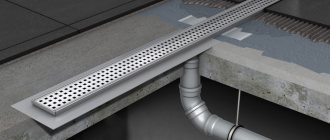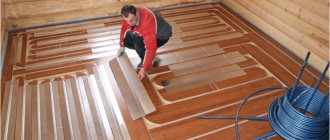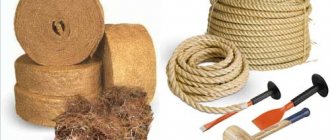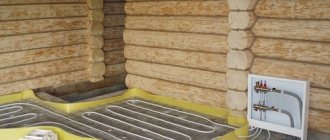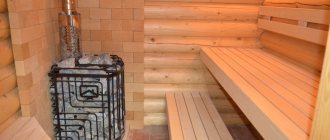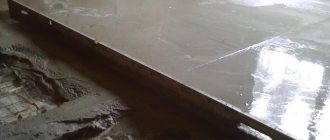When visiting a bathhouse, the greatest discomfort is caused by the uneven distribution of heat in the horizontal projection:
- Burning heat near the ceiling;
- Warm air in the middle;
- And the cold pulling down my legs.
The specific location of the stove in the bathhouse does not make it possible to influence the situation. The only way to radically change such an imbalance is to modernize the floor in the bathhouse by placing an independent heat source in it.
Advantages and disadvantages
When installing a heated floor, the air is heated evenly and this completely eliminates the appearance of a convective draft, which is observed with radiator heating.
An electric floor helps in cases where the bathhouse is located far from gas lines. It has a number of advantages over other types of heating:
- Thermal insulation provided when installing a heated floor prevents heat from passing through it. Thanks to it, up to 40% of heat is retained.
- The installation process, if organized correctly, takes little time.
- Reducing the cost of heating itself, because unlike its centralized counterpart, it is turned on only when using the bathhouse, and not every day.
- All installation work can be carried out independently.
The disadvantages of heated floors include:
- electromagnetic radiation;
- expensive electricity (but this is a relative minus, since the bathhouse is not constantly heated).
Technical characteristics of an electric boiler for a bath
Indeed, electric heating units have many advantages when it comes to installation in a sauna. However, they can only be felt if the parameters and characteristics of the electric bath boiler are taken into account correctly.
Start with the network where you plan to connect it - this data will be your starting point in choosing the power parameter of the device. Here you can have 2 options: a single- or three-phase wire, that is, the voltage in it is 220 V or 380 V, respectively.
Another point is the power of the device itself. Thus, ordinary wiring with a voltage of 220 V will “cope” with an electric boiler with a power of up to 6 kW. If the wiring of the same 220 V is new, done correctly and efficiently, you can take a closer look at more powerful units - from 6 to 12 kW.
If you need a heating device more powerful than 12 kW, then you will not have a choice, since such devices operate only from a three-phase network. Although some manufacturers of electric boilers have models that can connect to both a 220 V network and a 380 V network.
When choosing the power of an electric boiler, experts recommend first of all focusing on the area of the room: to heat 10 m2, the device will require at least 1 kW. Also pay attention to models with power supply in pulse mode - they are not afraid of voltage sags in power lines.
Types of underfloor heating systems
In the bathhouse, all the same systems are used as in ordinary housing.
Water
Its design, consisting of a closed loop, is laid below floor level. It involves pipes in which hot water or antifreeze circulates under pressure pumped by a special pump.
The coolant is heated to a set temperature using an electric or gas boiler.
We also recommend looking at - Warm water floor under tiles: installation instructions
Electric
This system is better known as a “warm floor”, which consists of special heating sections. The expenses for arranging such a floor with daily use will return after 6 years, but for a bathhouse they will pay off much earlier.
Installation of such a coating will take only a week.
Infrared
This option is distinguished by its electrical safety and airtight design; infrared mats are laid on the sauna floor. Their gentle operating mode allows the use of such floors in wooden structures, such as baths.
At the same time, the height of the room is not lost, since laying such a floor will only require a couple of centimeters.
Features of underfloor heating without radiators
Let's start with the fact that expert practitioners do not recommend using underfloor heating without the support of a radiator system, and here's why:
- To impart a sufficient amount of heat to the room, you will have to raise the temperature of the floor surface to 30 ° C and higher, which is no longer comfortable for those living in the house.
- Radiators equipped with thermostatic valves respond faster to changes in room temperature than heated floors. The latter are more inert due to the massiveness and heat capacity of the screed.
- Any water boilers, except electric ones, cannot operate efficiently in the minimum combustion mode, when it is necessary to maintain a low coolant temperature. Imagine that the efficiency of gas and solid fuel units drops by 5-20%, and think how much fuel you will burn in vain.
If the gas heat generator is switched to normal operation by setting the water heating temperature to at least 60 °C, the burner will often ignite and turn off (the so-called clocking will appear), since the underfloor heating system does not require a large amount of heat. This mode is unsuitable for the heater; it can quickly fail.
For normal joint operation of gas and other boilers with underfloor heating, but without radiators, there is an optimal solution - installing a buffer tank. Even a small tank will allow you to avoid “clocking” the unit burning natural gas.
We will consider an example of installing a buffer tank together with a solid fuel boiler, which cannot do without it when supplying floor heating.
Installation
Before carrying out it, you should check the sealing of walls, window openings and doors. Then you will need to prepare the base; it must be level. Using a level, check the flatness of the base; if there are deviations, then eliminate them by performing a screed.
Initially, a location for installing the thermostat and access to communications are selected, if we are talking about electric heating; in the case of water heating, the location of the boiler, pipes and taps should be considered.
The installation work is different for each heating system and is described in more detail below.
Wet floor
Installation begins with the selection and organization of the location for the coolant supply. Holes should be made in the walls through which the pipes will pass and the necessary shutoff valves should be installed.
It is best to arrange an outlet for such heating to provide a free niche in the bathhouse, which can be converted into a cabinet so that the communications are invisible.
A mesh for fastening pipes is laid on the pre-leveled floor, which is secured using ties. The pipe must be folded in half to organize not only the coolant input, but also its output.
When laying pipes in a spiral, it is necessary to avoid kinks, which will reduce the permeability of the coolant.
After checking the installation of water heating, you can connect it to the taps (supply and return).
After this, a test run of the system is performed, which will help identify a leak, if any, and wait for the maximum pressure of the network, which will depend on the heating of the coolant.
At the end of the installation, the screed is poured and the floor material is subsequently laid.
The entire design of water heating is multilayered:
- waterproofing material;
- insulating;
- foil;
- pipes;
- screed with reinforced elements;
- finishing floor
Pipe laying patterns can be different, and although a spiral is often used, sometimes a snake or its double version is used.
Pouring the concrete screed through the laid pipes starts from the far wall and ends at the door.
It is imperative to provide for zoning the room according to beacons, and the concrete mixture poured over the pipes is leveled according to the rule to avoid distortion of the base of the new floor.
If semi-dry mixtures are used for pouring, then after about 6 hours the surface must be sanded so that it does not completely harden.
Dry floor
Its installation will depend on the choice of the type of electric floor, and it can be:
- film;
- cable;
- using heating mats.
Film
It is made of thin strips that emit infrared radiation, it is similar to solar radiation, only unlike the latter, it excludes the influence of harmful ultraviolet radiation. Flexible strips are made of carbon and sealed in a polymer film.
When laying such a floor in a bathhouse, you should first lay Isolon - the material will reflect the resulting heat upward. Then the heating elements are laid out, which are covered with plastic film.
The latter serves as waterproofing for heating elements. At the end of the installation process, the finishing coating is laid.
Cable
The convection type of underfloor heating consists of a heating cable that is laid on a mesh base. Cable flooring is sold in rolls.
Installation of this type of electric floor is a rather labor-intensive process; it is best to entrust it to specialists. It can be used under different floor coverings.
Infrared
The rod elements are called mats. Their name comes from the heating rods that are connected to the power wires. They are connected in parallel, so there is no need to worry if one element fails.
When considering infrared mats, they can be compared to a rope ladder. They are mounted in tile adhesive or cement screed protected with isolon.
For more information about installing an infrared floor, read the article - How is an infrared heated floor installed under tiles? Overview of methods
Comparison
For comparison, only the heating cable and amorphous tape remained.
This will look more clearly in the table, provided that the comparison is made not in absolute criteria, but in relative ones. That is, relative to each other.
| Heating cable | Amorphous tape | |
| Working temperature | 50–80˚C | 38˚C |
| Increasing floor height | Minimum 4 cm (1 cm cable + 3 cm tie) | 0.2 cm (thickness of mat with amorphous tape) |
| Actual heating area, relative to the floor | 1–3% | 20–30% |
| Zebra effect | Present | Absent |
| Heating rate/thermal inertia | Medium/high. To reach the operating mode, you need to heat the screed layer. | High/absent. |
| Energy consumption (all other conditions being equal for power and operation) | High | Low. Compared to the energy consumption of the cable system, it is 40–50% lower. |
Regarding uneven heating, it should be explained separately.
In the cross-sectional image of an electric heated floor, it is clearly visible that the amorphous tape heats up at a lower temperature of the working element, but at the same time the area is much larger than that of the cable.
In this picture
The principle of formation of the “Zebra” effect is schematically shown. The fact is that the minimum distance between the turns of the cable is 8 cm. And to the floor surface is at least 4.5 cm (3 cm minimum thickness of the screed + 1 cm thickness of the tile + 0.5 cm thickness of the adhesive composition).
The temperature sensor is located between the turns of the cable, at an equal distance, that is, approximately 4 cm.
At a superficial glance, the heating rate should be the same. But according to the Debye model (1912), during heat transfer, the phonon energy is weakened when moving from one medium to another. And in this case, there is a transition of thermal phonons from the screed to the glue, then to the floor covering.
If you increase the thickness of the screed so that the heating is uniform, this will increase the energy consumption and inertia of the structure.
A thinner screed will not be able to perform protective functions and at the same time the likelihood of cracking is much higher.
From all the above factors, it follows that the use of amorphous heating tape when organizing an electric heated floor in a bathhouse is the only investment option to achieve the optimal balance between price, efficiency and reliability.
Electric floor in the bathhouse
This is an excellent solution for country villages where there is no central heating, but it is worth considering the high energy consumption. Although with proper organization of installation and insulation of the entire bathhouse and its foundation, they can be significantly reduced.
Heated floor safety system
Before purchasing and installing one of the electric floor options, it is necessary to make calculations and determine the expected resource consumption and whether the network will withstand such loads.
There are also high requirements for the bathhouse premises:
- all components and the heated floor itself are installed only in dry and clean rooms;
- the top floor covering is laid carefully so as not to damage the heating elements located underneath it;
- the flooring is selected depending on the characteristics of the room.
Operating principle of electric floors
The surface of such a floor serves as a kind of transmission panel, radiating heat along the entire perimeter of the room. The heating element itself is a system of cables enclosed in a screed or located under the tile.
The principle of heating a room is based on the conversion of electrical energy into thermal energy, due to which the bath is heated.
The thermostat built into the system maintains a comfortable temperature, and if it rises too much, its automation is triggered and turns off the entire system.
And when the room gets cool, the system turns on again.
Recommended coatings
Installing an electric floor involves using not only tiles, but also laminate, parquet boards, linoleum and plywood.
Features of flooring materials:
- Tile. Ideal for both water and electric floors, it differs from its analogues in its high wear resistance, heat transfer and variety of design.
Sudden temperature changes typical of a bath do not affect the condition of the tile surface; it is also moisture resistant.But considering that a person can drip onto it when leaving the steam room or shower, it is better to choose a rough surface to avoid slipping. If one part of the floor is destroyed, there is no need to remove all the tiles; it is enough to replace the deformed products.
- Laminate. For a bathhouse, you should choose only a waterproof type, but do not confuse it with moisture resistant, these are two analogues of different strength and resistance to water.
You need to select a material with a thickness of at least 8 mm and lay it on a substrate or plywood.If its installation is carried out on a concrete screed, then it is carried out as a “floating” floor. When laying laminate on plywood, it is attached to it with self-tapping screws.
- Parquet. The material is known for its heat-conducting properties, but unlike laminate, it expands and deforms from moisture, which is why you need to keep the room dry. It requires a plywood backing, which must be at least 20 mm thick.
- Plywood. More precisely, its painted and laminated version is similar in thermal insulation to parquet boards and laminate, but costs less. A screed thickness of more than 6 cm is required under it.
If 20 cm plywood is used, it can be mounted directly on aluminum or wooden guides.It is often used for temporary floor covering.
Rules for laying electric flooring in wet rooms
In a bathhouse, installation work always begins with the formation of a base with the correct slope. Water should flow over this surface. Further steps are carried out on an inclined base. Laying steps:
- a heat insulator is being built;
- a heating element or several similar heating elements are installed;
- The floor covering is formed and secured.
Advice
The minimum required slope of 2 cm per meter or visually 1 degree should be observed. The slope should be formed towards one of the walls of the bathhouse. You cannot do it towards the center of the floor, since working with a bowl-shaped surface will be much more difficult.
Installation features
It is almost the same, but each individual species has its own nuances. Initially, it is necessary to prepare a pit well, which will serve to drain water.
In one of the outer walls of the bathhouse, install a pipe, the end of which will go into the collector, drainage ditch or other drainage point. The walls of an organized well must be secured to prevent them from being washed away.
Level the earthen floor and create a sand and gravel cushion 15 cm thick on it; it needs to be leveled and try to compact it more tightly. Pour a 7 centimeter thick concrete screed on top and then wait for it to cool.
Lay waterproofing, insulation on it, then heat-reflecting film. Then the installation process is slightly different.
For electric type
Laying the coolant starts from the thermostat.
Electrical rolls are laid from the far wall to the near one.
To save material and future resource consumption, you must first mark the places where wardrobes or other massive furniture will be installed and go around it.
When the rolled out roll reaches the opposite wall, it must be carefully cut to within a few centimeters. Then lay the next heating tape parallel to the previous one, as close as possible to it.
After installing the coolant, its operation is checked, the cable is connected to the network, if everything works properly and heats up normally, then you can proceed to laying the finishing coating.
For infrared type
The film model of electrical systems is a thick cellophane, inside it there are copper wires, and on top of the material there are graphite strips. The latter, under the influence of electricity, create infrared radiation, which heats not the air, but the floor covering.
There is also an option for such a heating system as plastic mats, for which there is no need to prepare a concrete screed; they are quickly installed and heated. It is better to place infrared mats in an area free from furniture; they should cover at least 70% of the floor.
It is advisable to decide in advance on the location of the mats, make a paper sketch, on which you can also schematically arrange the furniture in order to get around it.
The base for the thermal film should not have strong differences, a slope of 1 cm per 1 linear meter is acceptable, so that the heat does not escape into the floor, it is covered with a thermal insulating substrate.
You can cut the heating film only in the designated places, which are marked on it with a dotted line; if you start doing this diagonally, it will be irrevocably damaged.
When laying mats on the floor, you need to move 10 cm away from the walls. They are laid joint to joint, with a gap of 5 mm between them. The cut areas are pre-insulated with bitumen insulation.
When all the infrared mats have been laid, they proceed to installing the thermostat, and then the functionality of the “warm” floor and all its turns is checked.
Specifics of water floor construction
First, a heat-insulating substrate is applied: all debris is removed from the floor of the bathhouse and a heat-insulating layer is laid out. It consists of strips that are fastened together with heat-reflecting tape.
Then a pipe layout diagram is drawn up; to simplify the task, you can use a checkered notebook sheet.
It is preferable to choose a “spiral” scheme, with which the room will be heated evenly.
Clips for fastening pipes are placed on the floor, then the plumbing elements themselves are laid and connected to each other, at the outlet they are connected to the boiler. A distance of 20 cm must be maintained between the walls and pipes.
Recommendations for pouring screed
The concrete base for the finishing material is made taking into account the option of arranging a “warm” floor and the specifics of the room, which may be humid.
If these are electric floors, then a plasticizer is added to the solution to create a screed above them. When the infrared mats are fixed, the solution is poured onto them, and then they wait for it to harden.
The dried screed is sanded, and then finishing material is laid on it.
It is worth noting that the screed is carried out after all the rough work has been carried out in the room.
The rough screed under the water floor must be carried out along the beacons.
The walls need to be puttied about 15 cm from the floor, this will help install the damper tape. Expanded clay concrete screed has the highest insulating layer.
First, as for an electric floor, an insulating layer is laid using an adhesive composition, and then the surface is reinforced using a special mesh. It is laid on nickels, which separate it from the insulation by about 4 cm.
After placing the pipes, fill the finished floor with a solution containing a plasticizer and small fractions of crushed stone. You can also use leveling mixtures.
After all the work done to create the screed, you must wait at least 28 days for it to harden well.
If you use a self-leveling mixture, it will dry faster.
Flooring options
Attention! The main feature of the bath room is high humidity.
When installing an electric heating system, increased attention should be paid to waterproofing, and wooden components (subfloor, joists, coating) should be treated with a fire retardant.
There are two main designs of electric floors: cable (convection) and film (infrared).
Cable
The recommended power of cable floors for baths is 250 watts per square meter. Single-core and two-core cables are used.
The preferred option is a two-core one, it is easier to install: there is no need to connect both ends; an end coupling-plug is mounted on the other end. But the electromagnetic radiation of a two-core wire is higher.
A convenient option for cable-type flooring is mats. A mat is a heat insulation plate in which a cable has already been laid. Installation is faster and easier.
Disadvantages of cable floors:
- complex installation, requires a screed device;
- energy consumption is higher than that of film floors;
- If the cable is damaged at one point, the entire structure fails.
Pros: high reliability of the system, ability to adjust temperature conditions, suitability for all types of coatings.
Infrared
The film floor is a rolled thermal film consisting of flexible carbon strips 0.3 millimeters thick. The strips are sealed in a protective polymer shell.
Advantages of the film:
- can be used without a screed (although for mechanical reliability and better tightness it is better to use a screed);
- parallel connection of elements: if one fails, this will not affect the overall performance;
- there is no electromagnetic radiation, and infrared radiation is considered harmless;
- high strength: can be placed under porcelain stoneware and clinker.
Disadvantage: water resistance is lower than that of cable floors. It is better to use for relatively dry rooms - dressing room, rest room.
Common mistakes when laying heated floors
Negligence bordering on laziness can lead to unpleasant consequences and after installation of the heating system it will not work. The most common mistakes made by builders when creating heated floors are:
- laying an electric floor under furniture, as a result of which not only its integrity suffers, but also the cable itself from overheating in these places;
- it is necessary to clearly calculate and mark the placement of heating elements; if this is neglected, it may turn out that one area becomes very hot, while the other remains cold;
- you cannot use “warm floors” immediately after pouring the screed, this will lead to its cracking and problems with heating;
- Before laying the cable, everything must be thoroughly cleaned, otherwise small dust particles can cause the cable or mat to become clogged and it will stop working.
Device specifics and functionality
The bathhouse is built mainly separately from the main housing, so it is equipped with its own boiler and heating circuit. If you install a double-circuit model with a boiler, hot water will always be available. The downside of the solution is that in winter you will have to make sure that no water remains in the system; every time you use the steam room, it needs to be filled and drained.
If you are planning a sauna with a stove-heater, a single-circuit boiler will be sufficient; in this case, the water for hygiene procedures will be heated separately. When arranging a sauna, you should ensure that the equipment has two circuits - for servicing the water in the pool and for heating the bath rooms. When the complex has a swimming pool, the heating system can be organized using several methods:
- autonomous heating, powered by solar panels or a heat pump;
- heat exchanger and pump combined in a heating circuit;
- pumping antifreeze into pipes;
- installation of a flow heater with a heating element.
The priority is given to electric sauna boilers, which are supplied with a complete set of piping:
- circulation pump;
- filter designed for fine cleaning;
- thermostat;
- expansion tank;
- safety valve.
An example of an electric boiler for a bath
A useful option will be auto-shutdown elements that are triggered in an emergency situation: when a pressure drop or overheating occurs. The possibility of switching from summer to winter mode is welcome; in this case, energy savings are realized.
Overview of methods
Advantages and disadvantages
Advantages of installing an electric heating boiler for a bath:
- cost-effectiveness - with a competent approach to the selection of characteristics, you can find a model that will justify itself in terms of the ratio of functionality to resource consumption;
- ease of installation - the device does not require a separate room or chimney arrangement;
- environmental friendliness - as a result of using the unit, no emissions hazardous to the environment are generated;
- there is no need to purchase or prepare fuel;
- you can set and automatically maintain a specific temperature;
- advanced models are equipped with remote control programs and are able to function autonomously;
- no effect of dried air, the ability to interface with steam generators;
- fire safety;
- loyal price range;
- the devices do not require labor-intensive maintenance;
- operating conditions are characterized by high humidity, the “filling” of the units is well insulated.
In regions with periodic power outages, generators are often purchased to eliminate emergency situations. A significant disadvantage of electric boilers for baths is their vulnerability to power surges. For models that are not equipped with a built-in filter, it is worth purchasing a stabilizer.
Electricity as it is
Electric heated floors come in several types. The heater can be in the form of a wire - double or single. The two-core one is more convenient to install, it does not need to be ringed, it is laid in one direction and a plug is simply placed at its end.
The single-core wire is laid with the expectation that both ends need to be connected to the controller. Don't forget about the temperature sensor. Its installation is also mandatory and is done on the floor between the turns of the cable.
A system with a single-core wire is easy to install, but has a significant drawback: it produces high electromagnetic radiation. When using a two-core wire, electromagnetic radiation is much less due to counter magnetic fluxes.
For floors made in the form of rolls or mats, electromagnetic radiation is significantly lower. But there are restrictions on their use.
The power of thermal mats ranges from 150 to 450 W per square meter of surface. For bath floors, 250 W per square meter is considered optimal.
More about water systems
Water systems are laid in a snail or wave pattern. The first method is more difficult, but gives more uniform heating.
Do not forget that the water heated floor system requires a circulation pump - it will not work by gravity. Before filling the system with solution (covering it with a coating), be sure to pressurize the system (check it under pressure) - then opening it and eliminating the leak will be troublesome. Soldering and fittings along the laying route are not allowed; they are possible only in manifold cabinets.
Power control mechanisms
One of the main criteria for choosing equipment for a bath is temperature control tools. There are only 2 scenarios on the specialized market: stepped and smooth.
Models operating on the basis of several heating elements usually provide stepwise power adjustment. To change the operating mode of such a boiler, it is necessary to activate or turn off some of the heating elements. Depending on how many of them will be involved in the work, you can set 4 power levels from 25% to 100%.
Step power adjustment
But judging by user reviews, smooth adjustment is more comfortable and economical, since it can be used to set specific temperature parameters. A smooth transition between indicators is ensured using a rheostat.
You can find budget models on sale that are characterized by low power and do not provide adjustment tools at all.
